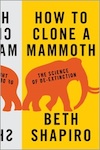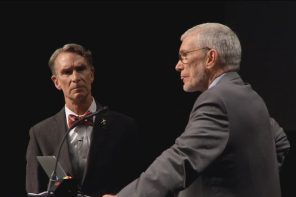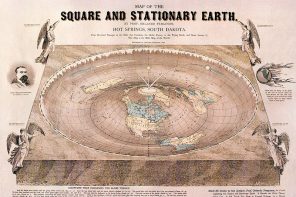In the storerooms of the Yale Peabody Museum of Natural History, in Connecticut, there’s a glass jar that contains a steak. The grayish meat floats in a solution of alcohol and water, unable to rot. According to legend, in 1951 it was cut from the thawing body of a giant ground sloth, transported to New York City, cooked with other sloth steaks, and served to the members of the Explorers Club for their annual banquet.
It would have been a hearty meal. Megatherium sloths could grow to weigh more than four tons. They roamed South America, eating plants (and possibly some meat), until they went extinct some 10,000 years ago. Fortunately for adventurous eaters, ice makes a good preservative, even across millennia. The Peabody Museum has its specimen thanks to one forward-thinking member of the Explorers Club, who popped his supper into alcohol. After all, flash-frozen Pleistocene mammals don’t emerge from ice every day.
As the sloth steak attests, the past is not always as distant as we think. The details of the Peabody story are apocryphal (results of a genetic analysis of the meat will be released later this year), but they aren’t entirely implausible: long-dead animals do appear in ice. And not all these ancient giants are as ancient as you’d expect; human beings had invented writing and built the Pyramids of Giza long before the last mammoth died in Siberia. Almost unimaginably strange worlds existed just outside that pinprick aperture in time that we call the present. Their remnants are visible, tangible, and, perhaps, edible.Is the magic of lost beasts what motivates UC-Santa Cruz biologist Beth Shapiro to dedicate her life to bringing back extinct species? Shapiro is a MacArthur “genius grant” recipient, a former Rhodes Scholar, and a geneticist. You feel like she might just as well be off trying to cure cancer or engineer superbacteria. Instead, Shapiro studies ancient DNA, and she’s an expert on the genome of the passenger pigeon, which has been extinct since 1914.
Shapiro is also at the forefront of efforts to bring extinct species, such as mammoths and passenger pigeons, back to life. In her new book, How to Clone a Mammoth, Shapiro offers an accessible, rigorous, I-can’t-believe-it’s-not-sci-fi guide to the world of de-extinction research.
You can read the book as a pop primer on genetics, a field guide to future fauna, or as a roadmap to the next generation of conservation science. But reading about these mammoths and Tasmanian tigers, you start to feel that Shapiro is getting at bigger questions. After all, while the science of de-extinction is hard, the ethical dilemmas are just as thorny. They force us to confront the peculiar challenges of restorationism—whether it’s theological, cultural, political, or ecological—all of which revolves around a single question: what, exactly, is the future of the past?
How to engineer a hairy elephant
“Mammoth cloning is not going to happen,” Shapiro writes in How to Clone a Mammoth. But don’t be disappointed. Geneticists can probably still bring them back.
Shapiro is a lucid, relaxed, and often hilarious guide to the strange world of people who try to resurrect dead species. (The book’s first sentence is indicative of Shapiro’s style: “A few years ago, a colleague of mine practically bit my head off for getting the end date of the Cretaceous period wrong by a little bit.” It’s charming, but, importantly, she doesn’t overdo it). Shapiro feels dorkily optimistic about the possibility of de-extinction. But she’s also frank about the challenges that confront anyone trying to give mammoths and other species a second shot at the Darwinian struggle.
The technical problems are straightforward: cloning is really, really hard, even when your original is a living, breathing, fully-nucleated sheep. Plus, DNA degrades quickly. Jurassic Park-style dino-DNA-xeroxing? Not going to happen. After all that time, there’s no coherent DNA left to copy. Even when a beautifully preserved mammoth emerges from the ice, raw meat clinging redly to its bones, the genetic material tends to be badly fragmented.
What researchers can do is extract whatever mammoth DNA they’re able to find, and then, with time, piece together a picture of the whole genome. Once they compare this reconstructed genome with that of the mammoth’s closest living relative, the elephant, geneticists can figure out the key ways the two differ. Then they can synthesize unique mammoth genes and begin inserting them into elephant embryos, making them more and more mammoth like.
Why bother? It’s not just that mammoths are 100% whiz-bang awesome (although they are), it’s that they were, for many millennia, integral parts of the Arctic tundra ecosystem, promoting botanical diversity and churning up the dirt. In doing so, they helped the permafrost stay frozen, instead of releasing its enormous stores of trapped CO2 into the air. It’s possible, writes Shapiro, that mammoths would “actually slow the accumulation of greenhouse gases in the earth’s atmosphere, and therefore the rate of global warming.”
The considerations go beyond cost-benefit analysis, though, and to questions of culpability and obligation. As is the case with many large, extinct animals, human hunters probably played a role in the extinction of the mammoth. Already, our society goes to great lengths to protect species from disappearing. Wouldn’t undoing some of that damage be a continuation of our efforts to preserve the world’s biodiversity? Shapiro observes that “people tend to be more interested in bringing back species that went extinct because of human activities.”
This all might sound like a conservationist’s dream. But what we’d get from all this tinkering won’t exactly be like the mammoths of old—just a hairy Asian elephant that’s a very, very good replica. And as the observant reader will have noticed, this resurrected mammoth, or passenger pigeon, or Steller’s sea cow, would, in fact, be a GMO.
The problems with de-extinction
There’s something of a paradox here. Human tools and ingenuity helped drive many species into extinction. In fact, human craftiness is exactly what corrupted so many of our pristine pasts, either real or mythical—Paleolithic tundras; pre-industrial villages; the Garden of Eden.
But re-creating the past often requires a whole new round of human ingenuity and manipulation. The de-extinction of mammoths would involve tools like PCRs and CRISPRs, as well as hyper-specialized techniques like epigenome reconstruction via the analysis of deaminated cytosine bases (how quaint!). In short, de-extinction, like extinction, would be a display of human power—an expression of our control over nature.
Other potential problems are just as knotty. Shapiro chronicles them with evenhanded precision. Would bringing back extinct animals revive dangerous pathogens? (Probably not). Would it be cruel to the animals themselves? (In some cases, probably; organismal engineering is complicated, and there could be gruesome failures). Will de-extinction distract us from the current tide of endangered species? Will it make extinction seem less awful, weakening conservation efforts?
De-extinct species may wreck existing ecosystems, too. After all, tundra and forests have adapted to the loss of key species, such as mammoths or passenger pigeons. Bring them back, and something else may suffer.
There’s another problem, which goes beyond de-extinction, and which Shapiro doesn’t really address: when you set out to bring back the past, which past do you choose? If we bring back the mammoths, should we bring back the species that co-existed with them? If so, do we try to reconstruct, say, the Canadian tundra of 10,000 years ago, or 30,000 years ago? If the technology permits, should we go back farther? If we can’t (say, the DNA just gets too fragmented), then isn’t it just an arbitrary technical barrier that has defined our choice of which past to resuscitate, however imperfectly?
The thing is, we do have a method, often implicit, by which to identify the historical period that we most want to reconstruct. The benchmark seems to be the moment before humans (or, in some cases, European humans, or industrial humans) showed up. But that benchmark is itself imprecise, in that it tends to assume an unbroken, perfect past before “bad humans” got there, which we can then set about rebuilding. But, of course, things have always been in flux. We do not aim for the past, but for a past—one of many, not all of them alike.
Mammoths, hipsters, and ultra-Orthodox Jews
None of this seems to faze the preservation-and-resurrection minded among us.
One begins to wish that our science fiction accounts of the future were less, well, futuristic. All of our technological development only seems to intensify and enable our dreams of lost worlds.
There’s the Brooklyn of today, which seems more and more eager to model its aesthetic on the Brooklyn of the 1920s; there are the aisles of Whole Foods Market, where the Paleo Diet ethos tries to resurrect the foodways of pre-agricultural humanity; there are our national wilderness areas, designed to protect and restore the “primeval character” of the American landscape; and there are religious movements, such as ultra-Orthodox Judaism, working to maintain many of the smallest details of some past country and era.
Do these phenomena really have much to do with Shapiro’s mammoths? In fact, I think they do. In all of these cultural upwellings, we see that same desire to touch a piece of the past, whether it’s the Paleolithic tundra, the immigrant hustle of old New York, some preindustrial culinary paradise, pre-European North America, or the eastern European shtetl, shortly before the arrival of the Enlightenment.
And, as with Shapiro’s mammoths, you can only pull yourself into the past by using the techniques of the present and future. Hipster chic and paleo dieting couldn’t exist without the affluence and leisure delivered by an industrialized market economy. Both national parks and Jewish enclaves thrive on a mix of legal protections and subsidies that come with the modern state. It’s hard to set aside vast tracts of otherwise usable land, or study Talmud all day, without the astonishing material wealth of a society founded on the division of labor and high-tech agriculture, such that fewer than 2% of people need to farm.
Nor are any of these reproductions perfect, or even close. The problems, often, are similar to those with de-extinction: the DNA of the past comes to us fragmented. Our information about diets and folkways is imperfect. Our primeval wilderness areas, for example, are often missing key pre-European species, including, of course, permanent human inhabitants. Future mammoths would really be hairy GMO Asian elephants, as noted above; but what reconstruction of the past is ever anything but a chimera, cobbled together from analysis and guesswork?
Nevertheless, we dream of perfectly cloned mammoths and second comings. It infiltrates our politics, dreaming of a return to a better America. It permeates faith: Jesus is the new Adam, the theologians say; the final chapter of the final book of the New Testament—and so for Christians, the entire Bible—discusses the Garden of Eden, where it all began.
Amidst this restorationism, Shapiro’s book is that rare thing: a truly progressive text with a profound interest in the past. Shapiro is excited about de-extinction, but she’s frank about the challenges and limitations. Unlike many people who enthuse about deextinction and its conceptual cousin, rewilding, she doesn’t sketch out a vision of entire ancient landscapes, reconstructed, but a more modest strategy for bringing back certain species, in order to meet contemporary needs and obligations.
And while Shapiro looks back, she’s comfortable with the technology required to give us our pre-industrial treasures. Discussing objections to de-extinction, Shapiro describes those who feel that, “by engineering new organisms, by altering the structure of biological communities, and by altering the course of today’s extinction trajectory, we are messing with things that we don’t understand and therefore probably shouldn’t be messing with.”
Shapiro takes that concern seriously. But she doesn’t buy into that fantasy of a world in which it’s possible for humans to exist without messing with things, including that which we don’t fully understand. That’s the fantasy, really, that underlies so many of our visions of simpler times. “With the earliest attempts at domestication of gray wolves in Europe some 30,000 years ago,” she writes, “our species began manipulating the genetics of other organisms to our advantage.” We have always been manipulating. We always will be. In that sense, at least, the future really is a reflection of the past.






